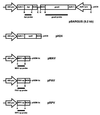Transgenic DNA integrated into the oat genome is frequently interspersed by host DNA
- PMID: 9770447
- PMCID: PMC22792
- DOI: 10.1073/pnas.95.21.12106
Transgenic DNA integrated into the oat genome is frequently interspersed by host DNA
Abstract
Integration of transgenic DNA into the plant genome was investigated in 13 transgenic oat (Avena sativa L.) lines produced using microprojectile bombardment with one or two cotransformed plasmids. In all transformation events, the transgenic DNA integrated into the plant genome consisted of intact transgene copies that were accompanied by multiple, rearranged, and/or truncated transgene fragments. All fragments of transgenic DNA cosegregated, indicating that they were integrated at single gene loci. Analysis of the structure of the transgenic loci indicated that the transgenic DNA was interspersed by the host genomic DNA. The number of insertions of transgenic DNA within the transgene loci varied from 2 to 12 among the 13 lines. Restriction endonucleases that do not cleave the introduced plasmids produced restriction fragments ranging from 3.6 to about 60 kb in length hybridizing to a probe comprising the introduced plasmids. Although the size of the interspersing host DNA within the transgene locus is unknown, the sizes of the transgene-hybridizing restriction fragments indicated that the entire transgene locus must be at least from 35-280 kb. The observation that all transgenic lines analyzed exhibited genomic interspersion of multiple clustered transgenes suggests a predominating integration mechanism. We propose that transgene integration at multiple clustered DNA replication forks could account for the observed interspersion of transgenic DNA with host genomic DNA within transgenic loci.
Figures




References
Publication types
MeSH terms
Substances
LinkOut - more resources
Full Text Sources
Other Literature Sources

